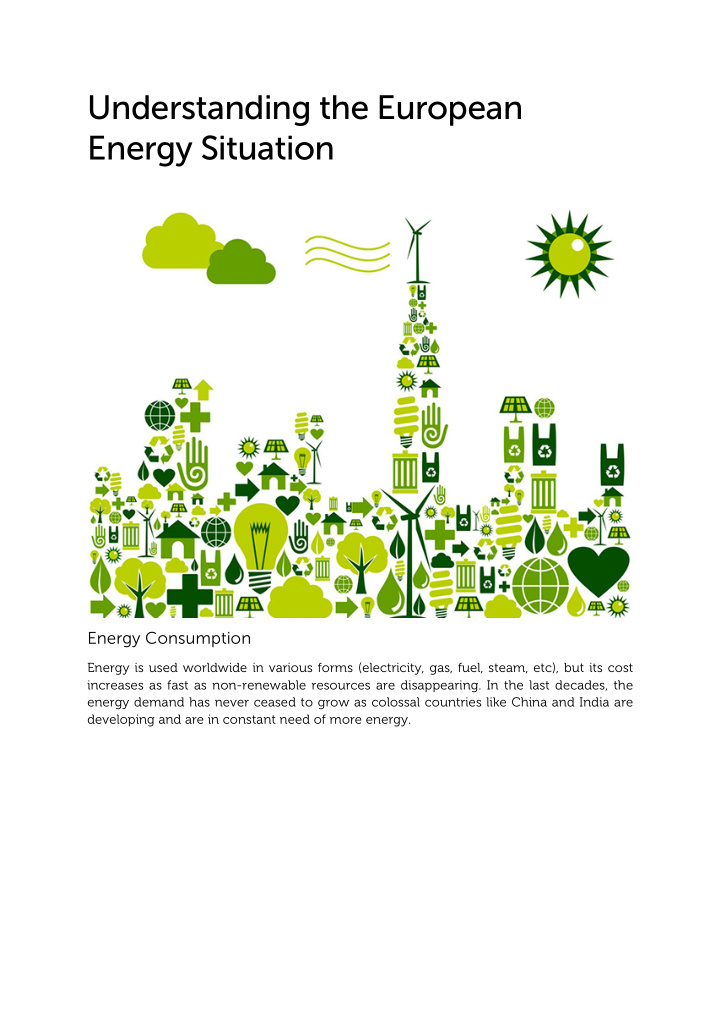



Understanding the European Energy Situation ¡ ¡ Energy Consumption Energy is used worldwide in various forms (electricity, gas, fuel, steam, etc), but its cost increases as fast as non-renewable resources are disappearing. In the last decades, the energy demand has never ceased to grow as colossal countries like China and India are developing and are in constant need of more energy.
Final ¡Energy ¡consump>on ¡EU ¡27 ¡ ¡ 1250 ¡ 1200 ¡ 1150 ¡ Mtoe ¡ 1100 ¡ 1050 ¡ 1000 ¡ 950 ¡ 1990 ¡ 1991 ¡ 1992 ¡ 1993 ¡ 1994 ¡ 1995 ¡ 1996 ¡ 1997 ¡ 1998 ¡ 1999 ¡ 2000 ¡ 2001 ¡ 2002 ¡ 2003 ¡ 2004 ¡ 2005 ¡ 2006 ¡ 2007 ¡ 2008 ¡ 2009 ¡ 2010 ¡ Source: European Commission – Eurostat In the European Union, even if the energy consumption has been relatively stable for the last decades, it is still very dependent on fossil fuels such as oil, gas and coal, which accounted for 74% of the European Union gross inland consumption in 2012. Just as every other country, Europe will be greatly affected by the increase in cost for fossil fuels. Source: European commission – Eurostat
C0 C02 Emissions As we know, our energy consumption also affects our environment as it produces CO 2, which is a greenhouse gas. But even if the European Union is a major supporter of the Kyoto protocol and has reduced its gas emission, it is a long term commitment that is far from being over. ¡ Total ¡CO2 ¡emissions ¡in ¡the ¡EU-‑27 ¡ 4,600.00 ¡ 4,400.00 ¡ 4,200.00 ¡ 4,000.00 ¡ Mtoe ¡ 3,800.00 ¡ 3,600.00 ¡ 3,400.00 ¡ 3,200.00 ¡ Source: European Environment Agency
Energy Consumption by Sector More than half of the global European energy consumption is used by industry and transport. Industry, for instance, is using every kind of energy, but most energy consumption is divided between oil, gas and electricity. Therefore these fields will be the most affected by the increase of energy costs and therefore the most likely to want to manage their energy usage. Source: European commission - Eurostat ¡ ¡ Electricity Production Electricity is produced through several kinds of energy, therefore its price is dependent on non-renewable sources. It is then likely to increase in the decades to come. Moreover, in some developing and emerging countries the governments are stopping to subsidize electricity and they will suffer from these higher prices much sooner.
Source: European commission – Eurostat ¡ Challenges There are many barriers to overcome to obtain industrial energy efficiency: • Management focus on production and not energy efficiency • Lack of understanding of financial, economic and quality benefits • Lack of adequate technical skills for energy efficiency measures and projects • Poor monitoring systems and data • Technology and equipment bias • First costs more important than recurring costs • Energy Efficiency resides with individuals rather than with the organization, so there are sustainability risks • Financial constraints ¡ Ways to become more efficient In order to become more energy efficient organizations need to follow a structured framework. The key steps are:
Considering the current energy and electricity context, it is expected that the European Union is more and more concerned with environmental issues and the future lack of fossil fuels. It is not surprising to see the appearance of European directives on energy efficiency, reduction of greenhouse gases and the use of renewable energies. Sources: http://epp.eurostat.ec.europa.eu/portal/page/portal/energy/data/main_tables http://www.eea.europa.eu/data-and-maps/data/data-viewers/greenhouse-gases-viewer Author: Agathe Jaillon ¡
Recommend
More recommend